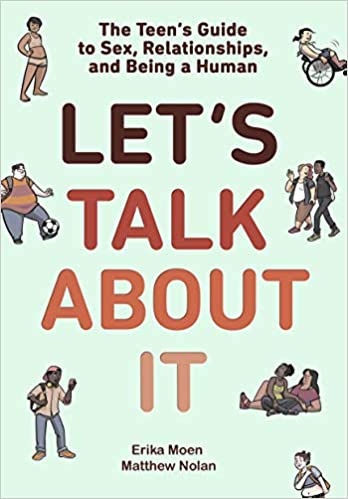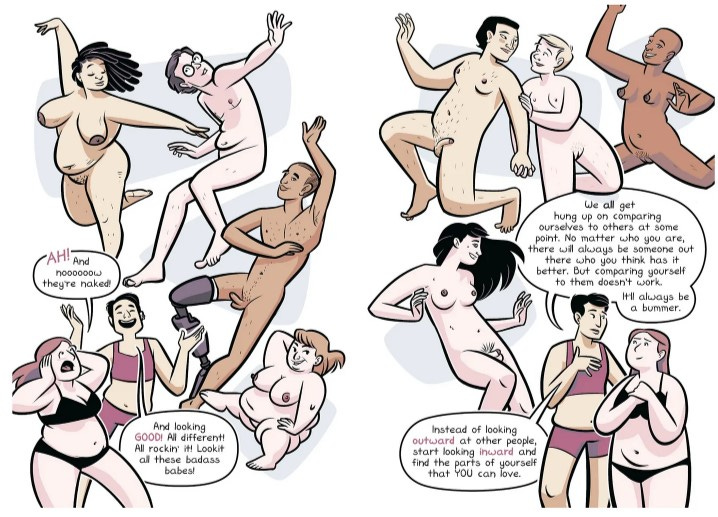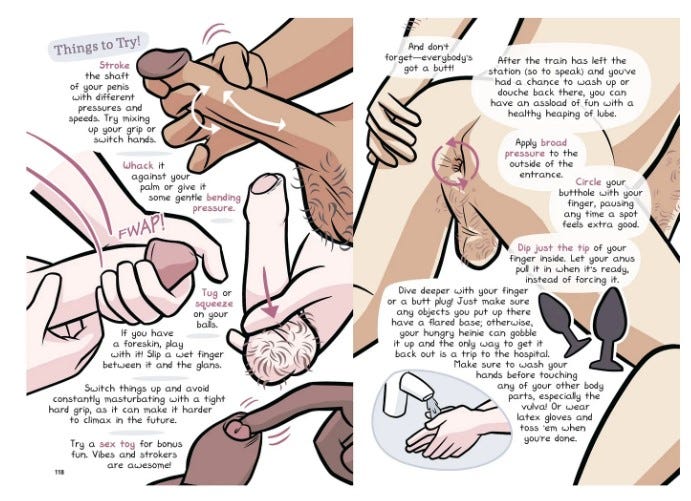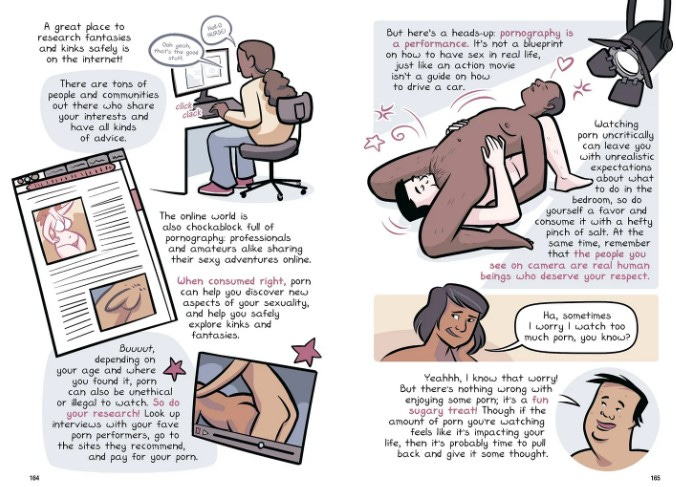Let's Talk About "Let's Talk About It" -- Pornographic Instruction Packaged for Teens (and Younger!)
Sexual Grooming Book provided by MA Public Schools
At MIP, we believe it is the responsibility of adults to protect minors from pornography and sexualization, and it is the parent’s right to decide when their child is ready to consider other controversial or mature subjects. To protect kids and honor parental rights, we regularly alert parents to books found in school libraries containing graphic sexuality and other forms of objectionable content. We want parents to know what books are showing up in school libraries so they can protect their kids and sound the alarm to other parents who share their concerns. To see our Parental Advisory Book List, click HERE.
Today we are on RED ALERT because one of the titles on our advisory list, Let’s Talk About It by Erika Moen and Matthew Nolan, is showing up in libraries in MA schools and it is THE worst book we have come across so far. We have found it in the Old Rochester Regional, Cambridge, and Barnstable districts. It is likely in many more.
Let’s Talk About It is a graphic novel published by Random House Children’s Books. It is available in both print and ebook formats. The cover subtitle bills it as: “A Teen’s Guide to Sex, Relationships, and Being a Human.” A more fitting subtitle would be “A Minor’s Guide to Sexual Grooming and Exploitation, Gender Confusion, Pornography, Sex Toys, Kinky Sex, and More.” Let’s Talk About It contains graphic imagery of genitalia in various forms of arousal, but that’s only the tip of the massive iceberg of problems that exist behind its cutely drawn cover.
We found graphic images and controversial ideology on so many pages of this book that a complete review is not possible. However, here is some of the most objectionable content in the book that parents should know about:
Grooms children into thinking that sex is no big deal. The book begins with a scene of teenagers playing a game called Seven Minutes in Heaven. A couple goes into a closet and the girl confesses to the boy that she is a virgin and says “…I’ve never even kissed anyone.” (p. 15) See the picture below for his response. He then goes on to say (p. 18) “…chances are you’re not the ‘perfect virgin.’ See, ‘virginity’ is a silly label people came up with to describe a person who hasn’t done a specific sexual act… But since there are SO many ways to have sex between SO many different kinds of people and body parts, you can be a virgin in one kind of sex act and totally NOT a virgin in others. ‘Virginity’ just doesn’t work anymore in today’s world.” The girl, who has never even been kissed, is talked out of remaining a virgin by being told that the concept is meaningless. Her boundaries for sexual intimacy are reduced because lesser acts of affection are placed on the same level as intercourse (and she has intercourse with him later in the book, when we see them topless in bed together on p. 171).
Promotes casual sex with multiple partners: “Romantic relationships come in different flavors. There’s no wrong choice. You can explore as many or as few as you fancy.” (p. 33) The relationship options are then defined as monogamous, polyamorous, open, casual (friends with benefits), and companionate. (pp. 33-34) The advice, “Chat it out before you pound it out,” is given to help young readers avoid going into a sexual encounter with unreasonable expectations. (p. 35) Page 91 (see picture below) teaches, “Reproduction aside, your genitals exist to let you feel pleasure with yourself or others (no matter which genitals they may have). Sexual intimacy is a powerful way to feel good and bond with another person, whether it’s for a night or a lifetime.”
Promotes gender and sexuality confusion: The characters illustrated in this book are often intentionally gender-ambiguous, and it is made clear repeatedly that the authors do not believe in a gender binary. Terms such as cisgender, agender/genderless, bigender, gender-fluid, gender nonconforming, nonbinary, genderqueer, and transgender are promoted as factual, and the reader is told, “You and your gender can change as often as you want!” (pp. 48-49) The use of preferred and atypical pronouns is reinforced throughout the book. Readers are instructed: “For a lot of people, He/Him or She/Her just don’t WORK, as they don’t match their gender, so they use a different set of pronouns. They/Them, Ze/Zir, Xe/Xem - there are a bunch of pronouns to choose from… Be awesome. Use people’s pronouns just like you want them to use yours.” (pp. 50-51)
Desensitizes children to nudity and promotes unscientific ideas about biological sex: Naked images of developmentally mature people are shown throughout the book. Many of these images, like the ones above (pp. 64-65), include combinations of sex characteristics that do not naturally occur. It teaches: “Bodies typically fall into one of two types, depending on their anatomy, genetics, and hormones… Lots of people also medically change their bodies to have the traits that are right for them: this includes cisgender, transgender, and nonbinary people.” (p. 78) The graphic on that page shows four nude adults, two of which are transgender (one has a penis and breasts, and one has a male-appearing body with no penis). Rather than defining people as male and female, they are defined as “Generally Testosterone-Rich Bodies” or “Generally Estrogen-Rich Bodies.” (pp. 79-80) On page 80 the “Generally Estrogen-Rich Body” includes a nude feminine-looking person with large breasts and a penis jumping in the air.
Gives instruction on masturbation and sexual activity: See photo above. On page 82 next to a picture of a nude male bending over it states: “Anus: Both practical and pleasurable, this tight, flexible hole serves two purposes… The opening is ALSO chock-full of sensitive nerves, making it a primo erogenous zone for touching and penetrating.” Pages 116-117 teach, “…the first thing to learn is that a HAPPY vulva or penis is a WET vulva or penis. Use lots of lube!… Things to try… Trail your fingers around or over your vulva… Tug, pull, and rub your labia… Later on, try adding a sex toy to your masturbation!…”. All of these instructions are illustrated. These are only a few examples; there are many more.
Teaches about kinks and promotes pornography: The chapter “What are… kinks, fantasies and porn?” begins with a scene of a young couple who just had sexual intercourse. We see the naked male remove his used condom and throw it into a garbage can. (p. 158) He then asks his partner what she was thinking about during sex and says, “How about I tell you some of the wild things I think up when I’m getting off if you tell me yours?” (p. 159) Throughout this dialogue, she confesses her kink to him, and he assures her that it is no big deal and that “The stuff that goes through your head is private and yours alone. It doesn’t define you. What you do in the real world - your verbal, online, and physical actions - that’s who you are.” (p. 161) The conversation then turns to trying out kinks in real life and learning about kinks through pornography (see photo above). Porn is called “a fun sugary treat.” (p. 165)
Promotes other graphic resources: The authors of this book have also published a webcomic, “Oh Joy Sex Toy,” referenced on the copyright page of the book. If a reader googles it, they will be brought to the authors’ website which is significantly more graphic than the book and includes comics about topics such as bondage and reviews of specific sex toys. Pages 228-229 of the book include a suggested list for further reading that contains five additional graphic titles as well as the Planned Parenthood and Scarleteen websites. In the MIP FB group, we have exposed the many ways Planned Parenthood sexualizes minors and undermines parents and have also warned parents about the graphic content on the Scarlateen website. Click here to read our posts about Planned Parenthood and here to learn more about Scarlateen.
And while all of this content is disturbing, perhaps the worst (and most telling) part is that these authors do not think there should be an age limit for viewing this material. The inscription at the beginning of the book reads: “To whoever needs it, whatever your age.”
The ALA and School Library Journal think Let’s Talk About It is appropriate for students in 9th grade and up… a book that instructs kids that hugging and kissing are the same as sex (and that sex is no big deal), normalizes nudity and sexual behavior, asserts unscientific and confusing ideas about gender and sexuality as fact, and encourages kids to watch porn and explore sexual fetishes. But the professional organizations promoting a book that teaches 13-year-olds about butt plugs and kinky sex call us “book banners” and think we are the ones with the problem.
Let that sink in.
This is why responsible parents need to act. So, what can you do to protect kids from Let’s Talk About It? Here are some action steps:
Find out if this book is in your child’s school library. Visit www.gofollett.com, find your school, and search for the title in your school’s online catalog. If your school district doesn’t use this service, visit your school website and find the page for the library media center. Many districts will have a link to their online catalog there. If your school doesn’t have an online catalog or does not make it available through another online catalog, email your library media specialist and ask if this book is in the library collection.
Investigate if this book can be accessed any other way without parental consent. Check to see if it is in your local public library. Many parents do not realize that some school libraries allow students to request books from the public library via interlibrary loan (ILL). If your public library has this book, your child may be able to get it through ILL. Kids can also access ebooks through a website called Sora, available through many school libraries, or Libby, available through your public library. Find out the ways your child can access this book and create boundaries to protect them.
Talk to your child about sex and controversial ideology in an age-appropriate manner, before they run into graphic material elsewhere. Kids are naturally curious — if they see this book or others like it, they might pick it up if they don’t feel like they have someone at home they can talk to about sex. Foster open communication and trust by initiating a dialogue that they can pick back up on whenever they have questions. For some ideas on how to do this, check out this WEBSITE or this BOOK.
If this book is in your school district library, alert the school committee. Find out what your district’s procedures are for requesting reconsideration or removal of a book from the library and begin the process ASAP. Obtain a copy of the book and read passages from it at your next school committee meeting. Share this comprehensive report from BookLooks with school committee members, administrators, and other parents. If your school committee doesn’t see a problem with this material, maybe it’s time for some new school committee members!
Run for school committee. Parents are continually being stonewalled by woke MA school officials when raising concerns about graphic books. Many parents are realizing that the only way to affect change in their school district is to run for and win a seat on the school committee. We have a crisis of leadership in our public education system. MA public school students need responsible community leaders that will propose and support common-sense policies to protect minors from sexualization and promote sound educational standards. Be the one to stand in the gap to protect kids from victimization and sexual indoctrination in MA schools. If you are interested in learning more about running for your local school committee email massinformedparents@gmail.com for helpful training resources.
Start a grassroots effort in your school district to bring change. Waking up to the reality that there is a war waging for the hearts and minds of our children is the first step we take in protecting them. But simply being informed is not enough. An army of advocates who are willing to enter the fight is needed. We love our children. They are our future. It’s time to employ effective strategies to defend them. If you are interested in learning what you can do to join the fight, contact massinformedparents@gmail.com to learn about advocate training happening throughout the months of May and June.
And finally - if this book is in your school library, we want to know! Leave a comment on this post or email us at massinformedparents@gmail.com. And if you take action in your district, let us know that too! Positive action inspires more positive action, and we want to help you network with like-minded community members to support your efforts.










Peter Noyes elementary school lists this book in there online catalog. I’ve been keeping an eye out and up to now i thought they were ok— but now i have my doubts and will have to get more involved… I notified my granddaughters parents about this.
joined group thanks - but there’ 5 of you Richard so didn’t direct message (which one)